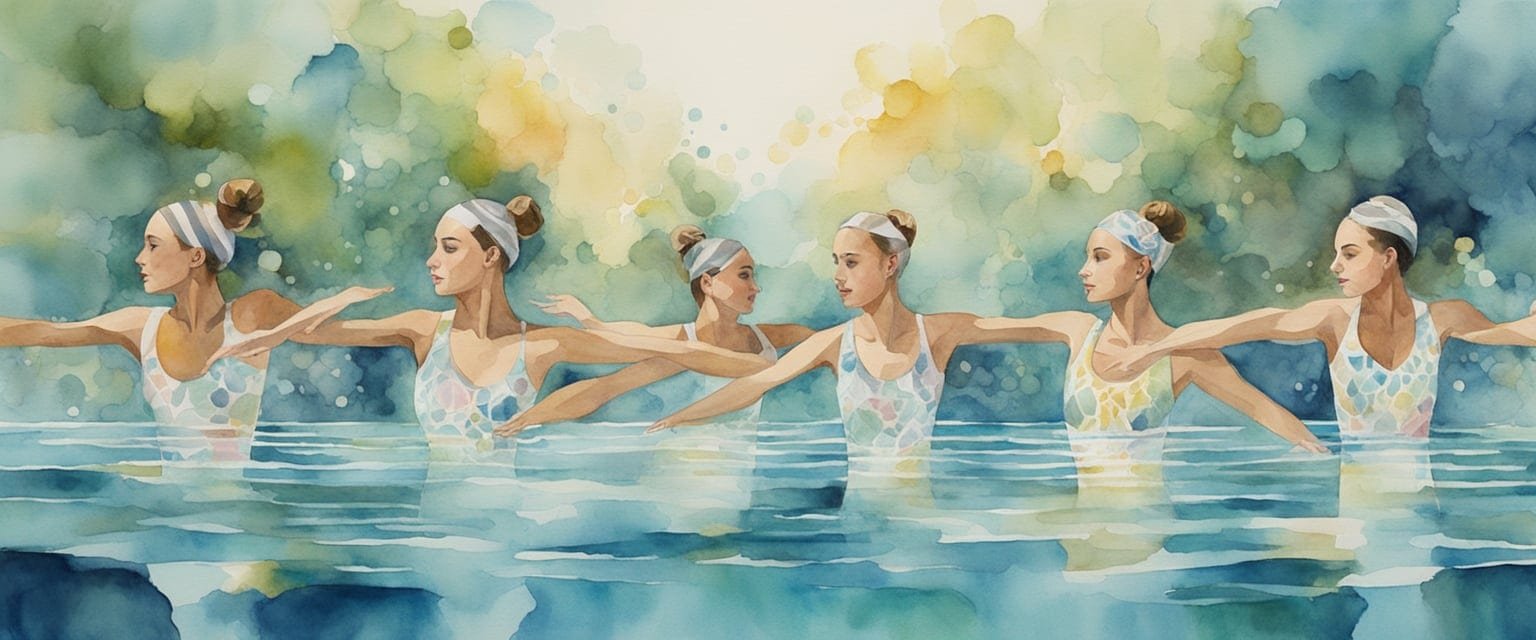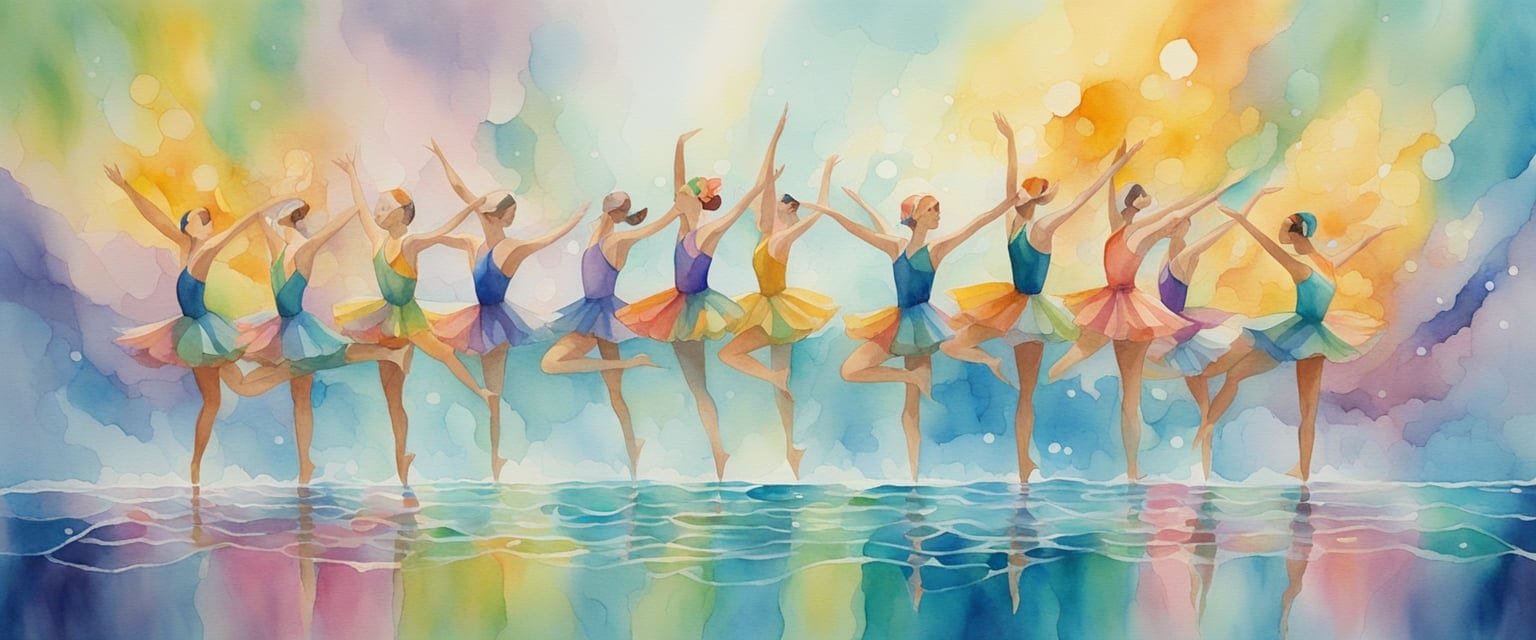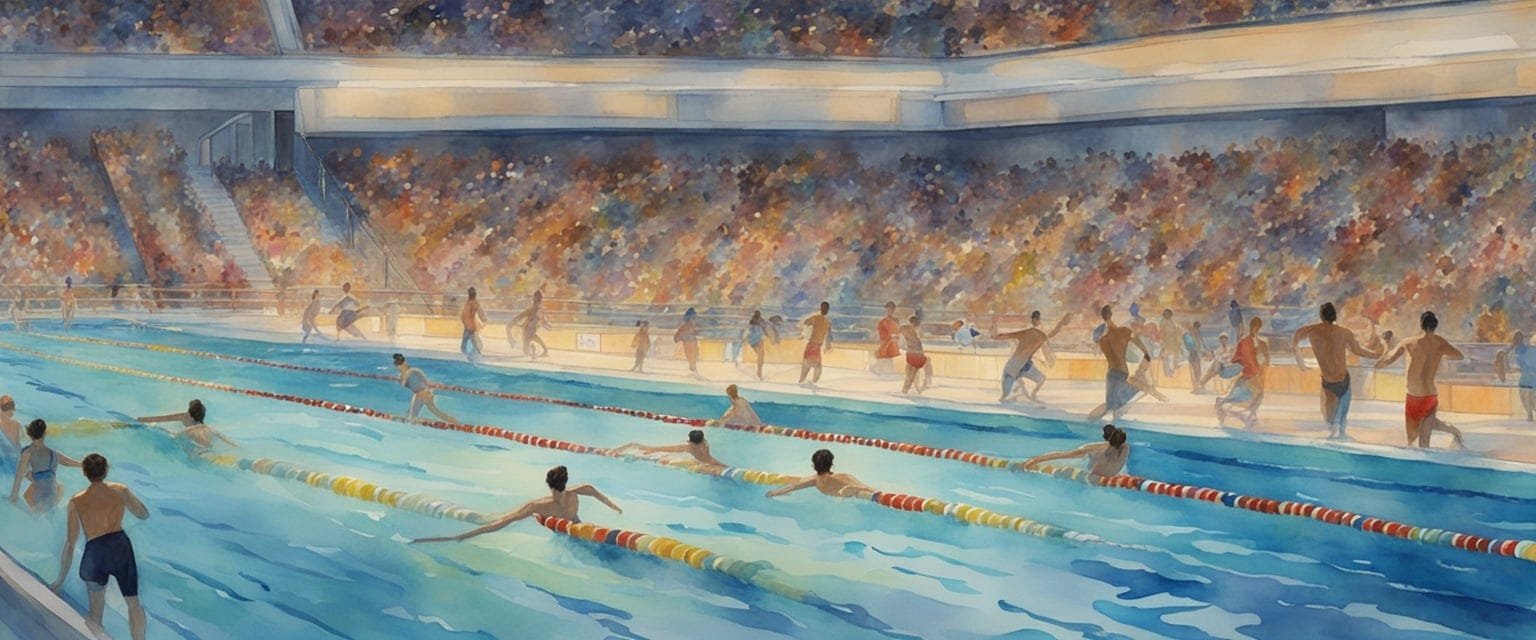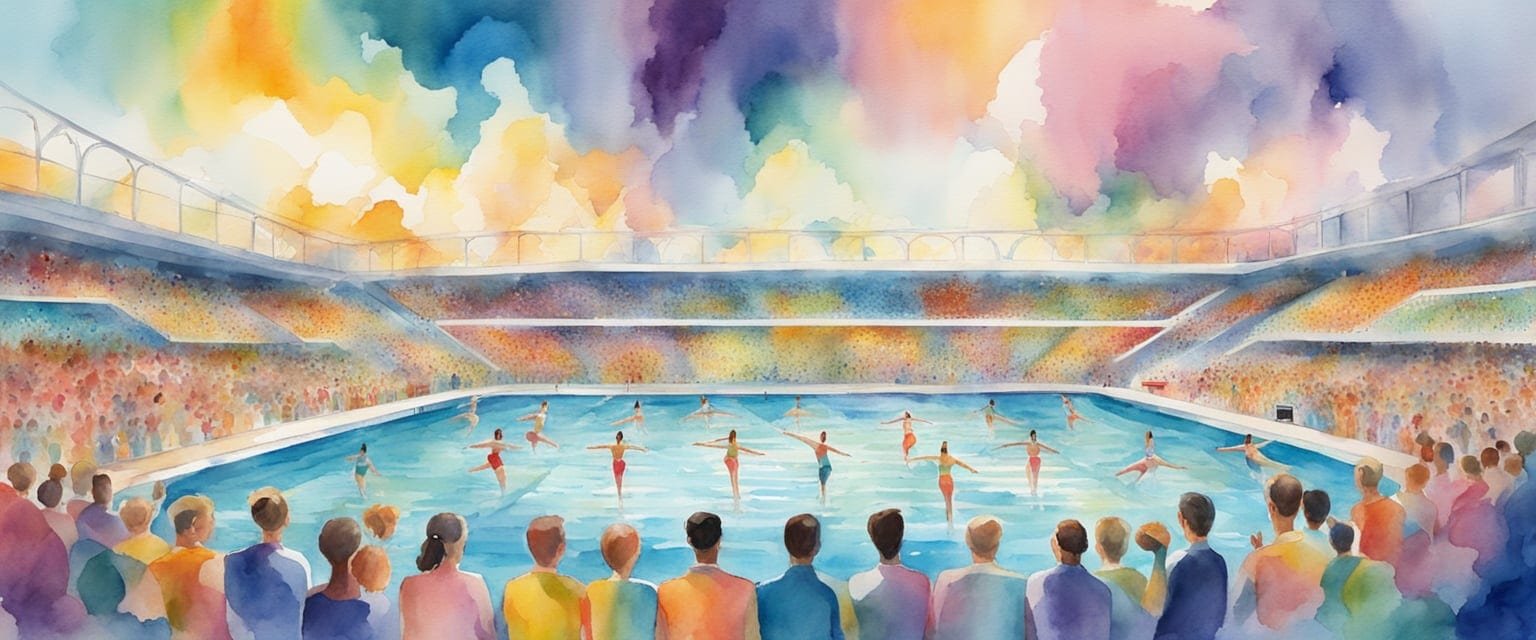Artistic swimming, once known as synchronized swimming, is a fascinating blend of sport and art that captivates many. In this ultimate guide to Olympic artistic swimming, I will take you through the essential elements of this incredible sport, from its rich history to the extraordinary athletes who make it shine at the Olympics. Whether you are a longtime fan or just starting to learn about the event, this guide will provide you with the knowledge and insight you need to fully appreciate the beauty of artistic swimming.

As I explore the competition format, the artistry involved, and the technical skills required, you’ll gain a deeper understanding of what makes this sport so unique. I’ll also share interesting facts about the athletes and the rigorous training they undergo to compete on such a prestigious stage. With the 2024 Paris Olympics on the horizon, there’s no better time to join me in uncovering the world of artistic swimming.
Key Takeaways
- Artistic swimming combines athleticism with artistic expression in the water.
- Athletes train rigorously to master the skills needed for competition.
- Understanding the judging process enhances appreciation for the sport.
The Essence of Artistic Swimming

Artistic swimming combines strength, rhythm, and creativity to create stunning performances. This unique sport has evolved over the years, showcasing the artistry and athleticism of its athletes.
Brief History and Evolution
I find the history of artistic swimming fascinating. Originally known as synchronized swimming, it became an Olympic event in 1984 during the Los Angeles Games. The sport evolved from water ballet in the early 20th century, blending dance and swimming into a graceful form.
As the years passed, the rules changed, and the routines became more complex. Artistic swimming now includes both solo and team events, allowing for a greater range of creativity. The inclusion of male athletes in team events for the first time at the Paris 2024 Olympics marks a significant evolution in the sport, making it more inclusive.
Understanding Artistic Swimming Elements
Artistic swimming is built on several key elements that create a captivating performance. Strength and endurance are essential, as athletes perform intricate movements while holding their breath. The athletes must maintain a strong core and precise control in the water.
Rhythm and artistry play a pivotal role too. Each routine is choreographed to music, requiring perfect timing and synchronization among team members. I love how athletes express themselves creatively, transitioning between elements such as lifts, spins, and formations.
These elements work together to create a visually stunning experience, showcasing both the beauty and athleticism of the sport. The balance of technical skills and creative expression makes artistic swimming truly unique.
Meet the Athletes

Artistic swimming showcases incredible talent and dedication. Learning about the athletes gives us insight into their rigorous training and the impact they have on the sport.
Olympic Greats in Artistic Swimming
Some of the most notable athletes in artistic swimming include Svetlana Romashina from Russia and Huang Xuechen from China. Romashina has won multiple Olympic gold medals, making her one of the sport’s legends. Huang also has an impressive record, securing her place among the elite swimmers.
In addition to these greats, I can’t forget about Sun Wenyan from China, who are known for her stunning performances. This sport has typically been dominated by women, but men will also compete for the first time in Paris 2024. Countries like Ukraine and Japan have been developing strong teams, enhancing the competition globally.
Training and Athleticism
Training for artistic swimming is intense and requires immense strength, flexibility, and endurance. Athletes practice for several hours every day, honing their skills in the water and on land. This includes a mix of swimming drills, dance routines, and strength training.
Balancing routines under water while holding one’s breath can be extremely challenging. Competitors must master coordination and timing, which is crucial for their performances. They also focus on artistic expression, making every movement count.
Athletes in this sport need to be exceptionally fit. Many follow strict diets and personalized fitness plans to support their training. This dedication highlights the commitment needed to excel in artistic swimming.
Understanding the Competitions

Artistic swimming competitions involve various formats and scoring systems. It’s exciting to see how athletes showcase their skills and creativity in both duet and team events. Here’s a closer look at these categories and how judging works.
Categories of Competition
In the Olympics, artistic swimming features two main categories: duet and team competitions.
Duet Competition: This involves pairs of swimmers performing together. Each duet showcases a combination of technical and artistic skills. They need to have synchronized movements and express creativity through their routines.
Team Competition: Teams consist of eight swimmers. They perform more complex routines that include various formations and group moves. The team must work together harmoniously to impress the judges.
Both competitions include two types of routines:
- Technical Routine: Swimmers must execute specific required elements that showcase their technical skills.
- Free Routine: Here, creativity takes center stage as duets or teams can incorporate their own choreography and style.
This variety keeps the competitions exciting and allows athletes to shine.
Breaking Down the Scoring System
The scoring system in artistic swimming is quite detailed. Judges assess performances based on two main criteria: technical elements and artistic impression.
Each aspect is rated on a scale of 0 to 10, with points awarded for difficulty and execution.
Technical Elements: Judges look for precision in movements, synchronization, and the inclusion of required skills. This can involve lifts or spins.
Artistic Impression: This focuses on creativity, choreography, and overall presentation. Teams and duets are encouraged to engage the audience and convey emotion.
For each competition, the final score is a combination of the scores from both routines. This scoring method ensures that both technical skills and creativity play a vital role in determining winners at the Olympics. The excitement builds as each nation vies for medals in these dramatic events.
Artistry in the Water
Artistic swimming is a beautiful blend of creativity and athleticism. The routines come alive through choreography, music, and stunning costumes that enhance every performance. I love how these elements work together to create an emotional experience for both the performers and the audience.
Choreography and Music Selection
Choreography is at the heart of any artistic swimming routine. I think of it as the intricate dance that combines gymnastic movements with fluid motions in water. Each routine must tell a story, showcasing the swimmer’s skill and creativity.
The music selection is equally important. It sets the tone and rhythm for the entire performance. Swimmers choose pieces that resonate with them, allowing them to express their emotions. I find that the right music can elevate the choreography, making the performance even more captivating.
The Role of Costumes and Makeup
Costumes play a vital role in artistic swimming. They are not just outfits; they are part of the performance. I appreciate how costumes enhance the artistry, often featuring bright colors and unique designs. They help to express the routine’s theme and must be functional for the athletes.
Makeup is also essential. It adds to the visual impact, highlighting facial expressions as swimmers perform. I love seeing how well-applied makeup can transform athletes into characters, adding depth to the performance. Together, costumes and makeup create a complete visual display that makes artistic swimming truly magical.
Technical Mastery
In artistic swimming, technical mastery is crucial for success. This involves a blend of skills that athletes must execute flawlessly, while also displaying creativity and synchronization with their teammates. I’ll break down the key elements of technical skills, routines, and the importance of timing.
Technical Skills and Routines
To excel in artistic swimming, mastering technical skills is essential. Each swimmer must learn specific elements required in both duet and team technical routines. These skills include:
- Figures: Precise body positions and movements.
- Transitions: Smooth changes between routines.
- Strength: Core and upper body strength for lifts and support.
Artistic impression also plays a significant role. It’s not just about the technical aspects; it’s about how I express emotions and creativity through my routine. Judges look for a combination of execution and artistry. A well-performed routine must showcase both technical abilities and creative expression to score high.
Synchronization and Timing
Synchronization is the heart of artistic swimming. It’s essential that I work closely with my teammates to create a unified performance. When I swim in a duet or team, every movement must be perfectly timed. This creates a visually stunning display.
Timing involves coordinating movements precisely with music. The rhythm of the music should guide my actions. If I’m even slightly off, it can disrupt the entire harmony of the routine. Achieving perfect synchronization highlights our hard work and dedication, making our performance captivating for both judges and audiences.
Judges and Scoring

When it comes to artistic swimming, judging and scoring are key elements that determine the success of each performance. The system is designed to evaluate both technical skills and artistic expression. Here, I will explain the criteria used for judging and what penalties can affect scores.
Criteria of Judging Artistic Swimming
Judges assess performances based on three main criteria: execution, degree of difficulty, and artistic impression.
Execution: This looks at how well the swimmers perform each element. Judges consider precision, timing, and synchronization.
Degree of Difficulty: Each routine includes specific moves with varying difficulty levels. Harder moves can earn higher scores if executed well.
Artistic Impression: This focuses on creativity, choreography, and overall appeal. Judges want to see how well the routine tells a story and engages the audience.
Scores are given for each criterion, and the combination of these scores leads to the final result for the team.
Understanding Penalties
Penalties can impact a team’s overall score significantly. Here are some common reasons for penalties:
Technical Mistakes: Errors in execution, such as missed moves or loss of synchronization, can lead to score deductions.
Time Violations: Routines must fit within a certain time limit. Exceeding this limit results in penalties.
Illegal Elements: Some moves are not allowed in competition. Including them can lead to substantial score reductions.
Judges closely monitor these aspects, and penalties can quickly shift the outcome of a performance. Each aspect of judging plays a crucial role in capturing the essence of artistic swimming.
Global Events and Competitions

Artistic swimming is featured in several key global events that showcase the sport’s talent and dedication. The Olympic Games and World Championships are two major competitions that highlight achievements and set the stage for future athletes.
The Significance of the Olympic Games
The Olympic Games are the pinnacle of artistic swimming. This event occurs every four years and attracts top athletes worldwide. Competing here is not just about medals; it’s an opportunity to represent my country and be part of something bigger.
In the Olympics, artistic swimming includes both duet and team events. Competitors perform free routines and technical routines, showcasing their skill, creativity, and synchronization. I find it fascinating to see how the competition evolves with every Olympics, as new techniques and styles emerge.
For the 2024 Paris Olympics, male athletes will enter the team event for the first time, a significant change that broadens the scope of the sport. Each performance is judged based on routine execution, artistic impression, and technical difficulty, making it an intense and thrilling competition.
World Championships and Their Impact
World Championships play a vital role in artistic swimming, giving athletes a platform to compete at high levels. These championships occur every two years and serve as a key qualifier for the Olympics.
During these events, I get to see the same excitement found in the Olympics, with athletes performing in duets and teams. The results from these championships often help shape rankings and influence selections for Olympic teams.
Countries like the USA and Canada traditionally excel, as seen in past events. Their success helps raise the profile of artistic swimming and inspires new generations. The World Championships also provide crucial experience, allowing athletes to refine their skills and showcase their talent on a global stage.
Behind the Scenes

In artistic swimming, there’s a lot happening behind the scenes that makes everything run smoothly. These elements include the critical roles of the coaches and support teams and the detailed preparation and logistics for the events.
Roles of Coaches and Support Teams
Coaches play a vital role in shaping the success of artistic swimmers. They create choreographies, focus on technique, and provide mental support. I find that their guidance helps swimmers to build confidence and perform at their best.
Support teams also help with various tasks. This includes trainers who ensure athletes remain injury-free and nutritionists who help with meal plans. Additionally, choreographers design routines that blend artistry with athleticism, keeping everything fresh and exciting.
Preparation and Event Logistics
Preparation for competitions like the Olympic Games is intense. Swimmers often train eight hours a day, six days a week. The Tokyo Aquatics Centre was a prime venue for showcasing these athletes.
Logistics are just as important. Teams plan travel, accommodation, and schedules. They also manage equipment and costumes, ensuring swimmers are ready for every performance. Event coordination helps create a seamless experience for athletes, judges, and spectators alike.
Frequently Asked Questions

I often get questions about Olympic Artistic Swimming that highlight important details of the sport. From rules and history to judging criteria and team sizes, here’s a closer look at some common inquiries.
What are the current rules and regulations for Olympic Artistic Swimming?
The rules and regulations for Olympic Artistic Swimming are set by World Aquatics. These guidelines cover everything from competition formats to scoring methods. You can find the most up-to-date information in their official documents, like the Artistic Swimming Rules – World Aquatics.
How do Olympic Artistic Swimming judges score performances?
Judges score performances based on several criteria. They look at technical skill, artistic impression, and synchronization. Each of these categories is carefully evaluated to determine the overall score of the routine.
Can you tell me about the history of Artistic Swimming in the Olympics?
Artistic Swimming has been part of the Olympics since 1984. It was originally known as synchronized swimming. The sport has evolved over the years, gaining more recognition and changing its name to better reflect its artistic nature.
What is the team size for Artistic Swimming in Olympic competitions?
In Olympic competitions, teams typically consist of eight members. There are also duet events, where pairs of swimmers compete. Each routine highlights teamwork and skill, showcasing the athletes’ abilities.
Are male athletes allowed to compete in Olympic Artistic Swimming events?
Yes, male athletes can compete in Artistic Swimming events. While the sport has been traditionally female-dominated, recent changes allow for mixed duets and greater male participation, promoting inclusivity.
What are the key elements judges look for in an Artistic Swimming routine?
Judges focus on several key elements during a performance. They consider synchronization, difficulty, creativity, and execution. A well-rounded routine that excels in these areas is more likely to score higher during competitions.

